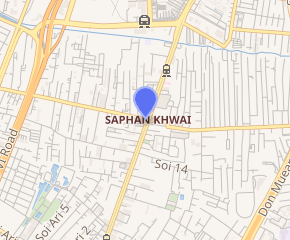Saphan Khwai
Saphan Khwai (Thai: สะพานควาย, pronounced [sā.pʰāːn kʰwāːj]) is a major road intersection in the Phaya Thai Subdistrict, Phaya Thai District, Bangkok, Thailand.
| Saphan Khawi | |
|---|---|
| สะพานควาย | |

| |
| Location | |
| Phaya Thai, Bangkok, Thailand | |
| Coordinates | |
| Roads at junction | Phahon Yothin (north–south) Saliratthawiphak (east) Pradiphat (west) |
| Construction | |
| Type | Four-way at-grade intersection with four-way footbridge and BTS tracks |
The surrounding neighbourhood is studded with many apartments and is best known for its many shops and markets. It is served by the BTS skytrain service at Saphan Khwai Station. From the 1960s, as the urban zone of Bangkok grew, the land which once had been countryside, mostly rice farms, became urbanized with more residential and commercial areas.
Location
In the northern zone of Bangkok's central business district at the junction of Phahon Yothin, Pradiphat, Sutthisan Vinitchai, and the short link of Saliratthawiphak Road. It is on the route of the Skytrain Sukhumvit Line between Ari and Mo Chit Stations
History
"Khwai" or water buffaloes were commonly used for ploughing by Southeast Asian farmers including Thais. In the past, Saphan Khwai was a farming area on the northern outskirts of Bangkok's core, next to the northern part of Phaya Thai District. It was irrigated by Khlong Sam Sen and Khlong Bang Sue, diverted from the Chao Phraya River. At the beginning of the 19th century, the Saphan Khwai Intersection was the meeting place for rice farmers, buffalo traders, and slaughterhouse workers. Roads at the junction, did not meet directly, but a small waterway along Phahonyothin Road carrying irrigation water from Khlong Bang Sue crosses Pradiphat Way. For the convenience of traders a bridge or "saphan" was built. It was upgraded from wood to concrete as traffic increased.
Today, although the fields and buffaloes have disappeared, the name "Saphan Khwai" is still used for this area. It means 'buffalo bridge'.[1]
Transportation
- BTS Skytrain: Saphan Khwai Station
- BMTA bus: route 3, 8, 26, 27, 28, 29, 34, 38, 39, 44, 52, 54, 59, 63, 74, 77, 90, 97, 108, 117, 157 (air cond.) 177, 204, 503, 509, 510, 524
References
- dish123 (February 2012). "สะพานควาย ชื่อนี้มีที่มา เป็นอย่างไร". Mthai. Retrieved 5 March 2018.